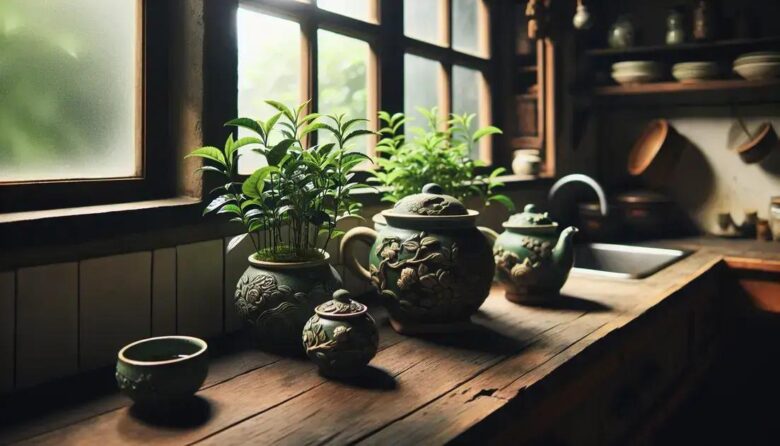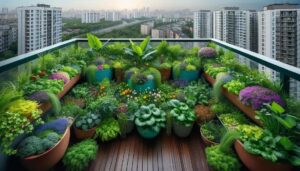Growing tea herbs in recycled ceramic pots offers eco-friendly solutions while ensuring proper plant health with optimal drainage and breathability. Container gardening provides flexibility, allowing easy control over soil and environmental factors for herbs like mint and chamomile, making it perfect for limited spaces.
Tea herbs in recycled ceramic pots offer a unique blend of sustainability and creativity. Ever wondered how such a simple container choice can elevate your gardening game? This journey into plant care isn’t just eco-friendly; it’s an expression of art and resourcefulness. Dive into the world where your morning brew starts from your own crafted pots.
why choose recycled ceramic pots for tea herbs?
Choosing recycled ceramic pots for growing tea herbs combines sustainability with aesthetic appeal. These pots are not only environmentally friendly but also offer unique textures and warmth to any garden setting. Unlike plastic containers, ceramic pots provide excellent breathability and insulation for plants, ensuring that soil moisture levels are maintained without overheating. By opting for recycled materials, you’re not just reducing waste but also giving a new life to ceramic items that might otherwise end up in landfills.
Moreover, ceramic pots are durable and can withstand weather changes better than many other materials, making them ideal for both indoor and outdoor gardens. Their weight adds stability, preventing them from tipping over in windy conditions. Additionally, the porosity of ceramic allows the roots of the plants to breathe, contributing to healthier growth.
Environmental Impact and Benefits
Recycling ceramics mitigates the impact of mining raw materials and reduces energy consumption compared to producing new pots. This choice supports a circular economy where resources are reused and repurposed. As gardeners increasingly seek sustainable options, recycled ceramic pots become a perfect fit for both environmental consciousness and functional planting needs.
With various shapes and sizes available, these pots can accommodate a wide range of tea herbs, offering flexibility in garden design. Consider incorporating recycled ceramics into your gardening practice to enjoy beauty and function while supporting environmental efforts.
benefits of growing tea herbs in containers
Growing tea herbs in containers offers numerous advantages, making it an ideal choice for both beginners and experienced gardeners. One major benefit is the ability to control the soil quality and drainage, which is crucial for the healthy growth of tea herbs. Containers also allow you to easily manage sunlight exposure by moving the plants to different locations, ensuring they receive the optimal amount throughout the day.
Additionally, container gardening minimizes the risk of pest infestation. Raised pots can keep harmful insects at bay and make it easier to spot any issues before they become serious. Container-grown tea herbs are less prone to soil-borne diseases, promoting healthier plants and a more abundant harvest.
Space and Flexibility
For those with limited space, containers are perfect for optimizing the available area, whether on a balcony, patio, or small backyard. This method allows you to create a portable garden that can be rearranged based on seasonal changes or aesthetic preferences. The flexibility of container gardening means you can experiment with different herb combinations to find what works best for your needs and tastes.
The focused care provided to each pot can lead to more productive plants. Individual attention to water requirements and specific nutrient needs ensures that each tea herb thrives. This personalized approach often results in richer flavors and higher quality harvests.
step-by-step guide to planting tea herbs
Embarking on the journey of planting tea herbs in containers is rewarding and straightforward. Begin by selecting high-quality seeds or young plants of your favorite tea herbs like mint, chamomile, or lavender. Choose containers with enough depth to accommodate root growth and ensure they have drainage holes to prevent waterlogging.
Next, fill the container with a well-draining potting mix enriched with organic matter. This provides essential nutrients and prevents compacted soil. Gently place the seeds or plants into the soil, making sure they are spaced correctly to allow adequate airflow as they mature. Pat the soil around the plants to stabilize them and ensure good contact for root growth.
Watering and Care
After planting, water the herbs thoroughly, ensuring moisture reaches the roots without oversaturating the soil. Establish a consistent watering schedule based on the herb type and environmental conditions. Monitor the plants for growth and moisture needs, adjusting care routines as necessary. Regularly check for signs of pests or disease and address any issues promptly.
Position your containers in a location where the herbs receive appropriate sunlight based on their specific needs. Most tea herbs thrive with six to eight hours of sun daily, though some may prefer partial shade. As the herbs grow, consider rotating the containers to ensure even growth and sunlight exposure on all sides.
creative ways to repurpose ceramic pots
Repurposing ceramic pots into unique pieces for your home or garden can be both fun and rewarding. One creative idea is to transform old pots into charming bird baths by stacking them together and adding a shallow bowl on top. This can attract birds to your garden and create a lovely focal point.
Another inventive use for ceramic pots is crafting decorative candle holders. By placing tealights inside and adding artistic designs or paints on the exterior, you can achieve a cozy, ambient light perfect for any setting. For added flair, consider arranging them in groups with varying heights for a dynamic display.
Indoor Use Ideas
Ceramic pots can also be repurposed indoors as organizers for kitchen utensils or art supplies. A large pot can hold spatulas and spoons within reach, while smaller ones can keep pencils and brushes tidy. With vibrant colors or intricate patterns, these pots double as functional decor.
Incorporating broken pottery pieces into mosaics is another creative outlet. Use these shards to craft unique tabletops or garden stepping stones, adding character and a touch of Mediterranean style to your space. Letting your imagination roam free with ceramic pots brings new life to items that might otherwise go unused.
maintaining and caring for your tea herb plants
Proper maintenance and care are key to thriving tea herb plants. Start by ensuring your plants receive adequate water. Most tea herbs prefer slightly moist soil, so it is important to check the moisture level regularly. Water the herbs when the top inch of the soil feels dry. Be cautious not to overwater, as this can lead to root rot.
Pruning is another crucial aspect of care. Regularly trim the leaves to encourage bushier growth and prevent the plants from becoming leggy. For herbs like mint or basil, pinching off the tips can enhance growth and flavor. Harvest the leaves frequently, as this promotes new growth and maintains plant health.
Pest Management
Keep an eye out for common pests such as aphids or spider mites. If detected, gently wash the leaves with water or use an insecticidal soap. Introducing natural predators like ladybugs can also help control the pest population without chemicals. Ensuring plants have proper airflow can prevent most fungal issues.
Fertilizing with an organic, balanced fertilizer every few weeks during the growing season can aid in providing necessary nutrients. Be mindful of the amount, as over-fertilizing can harm the plants. Place pots in an area where they can receive 6-8 hours of sunlight daily for optimal growth and flavor development.
how recycling supports a sustainable lifestyle
Recycling plays a crucial role in fostering a sustainable lifestyle, contributing significantly to environmental conservation. By recycling materials like plastic, paper, and metals, we reduce the demand for new raw materials, preserving natural resources and habitats. This process lowers the carbon footprint associated with extracting and manufacturing new products, significantly decreasing greenhouse gas emissions.
Implementing recycling in everyday life encourages mindful consumption. Individuals become more aware of their waste generation and can make informed choices that favor reusable and recyclable products. This awareness extends to supporting companies and brands that prioritize sustainability in their operations, further driving eco-friendly initiatives across industries.
Community and Economic Benefits
Recycling also boosts local economies by creating jobs in waste management and recycling industries. Communities that invest in recycling infrastructure witness improved waste management systems and reduced landfill use. These systems enhance the quality of life by ensuring cleaner neighborhoods and reducing pollution-related health issues.
Lastly, recycling encourages a circular economy where products and materials are continuously repurposed, extending their life cycle. This approach minimizes waste, optimizes resource use, and creates sustainable growth opportunities. Embracing recycling as part of a daily routine reaffirms a commitment to preserving the planet for future generations.
Sustainable gardening and a greener future
Incorporating tea herbs into your life using recycled ceramic pots is a wonderful stride towards sustainability. These choices not only enhance the beauty of your space but greatly benefit the environment.
Growing tea herbs in containers allows for flexibility, creativity, and a lush mini-garden right at your fingertips. As you repurpose ceramic pots and embrace container gardening, you also engage in an enriching, eco-friendly lifestyle.
Supporting sustainable practices such as recycling aligns with preserving our planet’s resources and nurturing harmony with the natural world.
By integrating these practices into daily living, you contribute to a more sustainable future for everyone. Every small action, like planting a tea herb or recycling a pot, plays a role in building a greener tomorrow.
FAQ – Common questions about tea herb gardening in recycled ceramic pots
Why are recycled ceramic pots ideal for tea herbs?
Recycled ceramic pots offer excellent drainage and breathability, crucial for healthy tea herb growth, while promoting sustainability.
What tea herbs grow best in containers?
Herbs like mint, chamomile, and lemon balm thrive in containers, as they allow control over soil and environmental conditions.
How often should I water my tea herbs in ceramic pots?
Water when the top inch of soil feels dry, ensuring moisture reaches roots without waterlogging to prevent root rot.
How can I repurpose old ceramic pots creatively?
Turn them into bird baths, candle holders, or use pieces in mosaics to give the pots new life and add charm to your space.
What are the benefits of container gardening for beginners?
Container gardening offers ease in managing watering, sunlight, and pests, providing flexibility even in small spaces.
How does recycling support my gardening lifestyle?
Recycling reduces waste and advocates for eco-friendly practices, enriching your gardening journey and supporting the environment.



